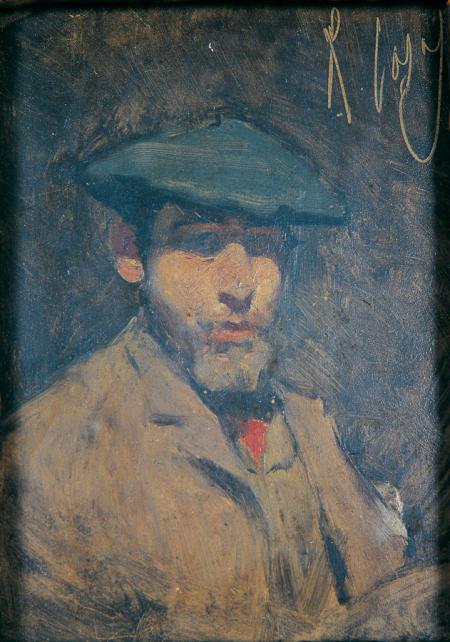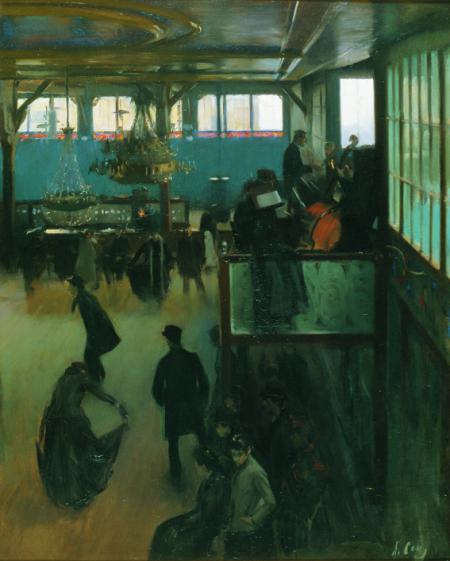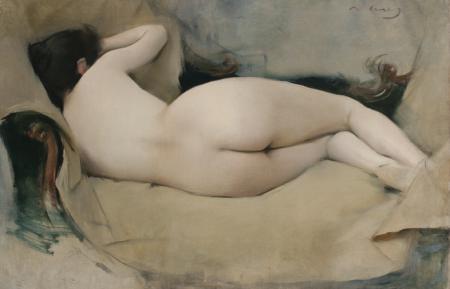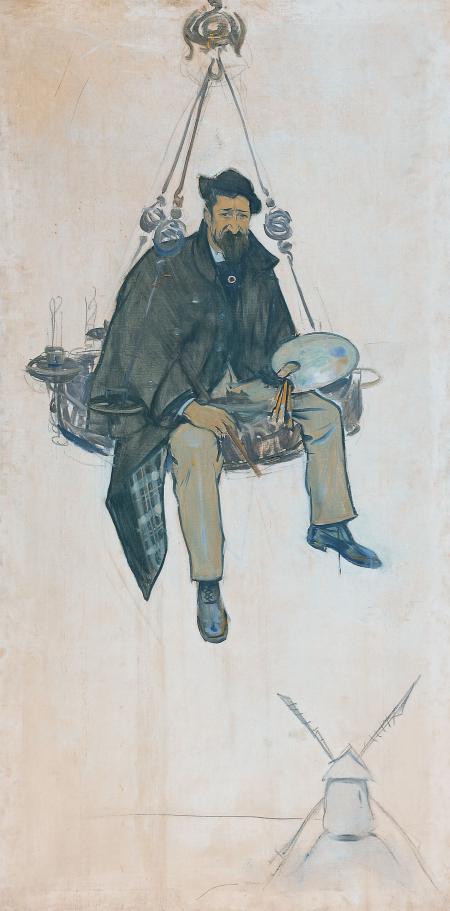Year Ramon Casas
The Cau Ferrat Museum and the Maricel Museum will jointly celebrate the Year Ramon Casas, a Year that carries its own weight, presence and profile. The two museums hold an important legacy of all the work of one of the most important figures of Catalan Modernism and Catalan poster making. The history of its buildings are directly related to Casas (Can Rocamora, which links the two museums, was owned by the artist). The curator of the commemoration represented by Vinyet Panyella, director of Museums of Sitges, award to the Heritage of Sitges a special role in this commemoration. The central exhibition of Year Ramon Casas will take place exactly at the museums of Sitges, and then will travel to Madrid and Palma de Majorca. The program includes other activities such as presentations, routes or editions, which are added to the national celebration. Year Ramon Casas is promoted by the departments of Presidency and Culture of the Catalan Government, in collaboration with a long list of institutions, museums, organizations and companies.
COLLECTIONS OF WORKS BY RAMON CASAS IN THE MUSEUMS OF SITGES
- Cau Ferrat Museum, Santiago Rusiñol Collection: 92 works (14 oils and 78 drawings).
- Cau Ferrat Museum, Cau Ferrat Collection: 3 pieces (two drawings and one oil).
- Maricel Museum, Art Collection of the City of Sitges One oil.
- Maricel Museum, Maricel Collection: 4 works (3 drawings and one tile panel).
OBJECTIVES OF YEAR RAMON CASAS
The commemoration of the Year Ramon Casas 2016 is organized into three core concepts:
- access
- awareness
- creativity
The set of activities are coordinated, promoted, and organized by the curator, in collaboration with institutions and organizations that contribute to fulfill all three aspects, often complementary. The following objectives were agreed:
- All kinds of audiences must achieve maximum participation and enjoyment
- Promote the commemoration of Ramon Casas in the entire Catalonia.
- Promote the integration of the activities in the program and services of museums, monuments and art collections with works by Ramon Casas open to the public, as well as various cultural agents.
- Assimilate into the commemoration various fields of activities that could evoke somehow the figure of Ramon Casas, such as the world of gastronomy, motor engines, among others.
- Contribute to the promotion and internationalization of Catalan culture through the figure of Ramon Casas, just as an icon of modernity and modernism.
- To inform in a permanent and prompt manner about all the activities in a totally accessible and updated way through the website that the Catalan Government devoted to Ramon Casas.
ACTIVITIES OF YEAR RAMON CASAS IN SITGES
The Piece of the Month: Ball al Moulin de la Galette (Dance at Moulin de la Galette) (1890-91) and Letter from Casas to Rusiñol where he announced his arrival in Paris in 1890
Both works are part of the collection of Cau Ferrat. The event was held on May 29 at the Maricel Museum and served as the starting point for all the activities of the Year Ramon Casas.
Exhibition: Ramon Casas, longing for modernity
Maricel Museum from 10 November 2016 to 19 February 2017. Curator: Ignasi Domenech (Sitges Heritage Consortium) and Francesc Quílez (MNAC). Organization: Heritage Consortium of Sitges, Sitges City Council, La Caixa Foundation. It is the central exhibition of Year Ramon Casas and will contain its own catalog.
Route Ramon Casas at the Museums Sitges
Start: Summer 2016.
Edition of Desde el Molino (From the Mill) by Santiago Rusiñol and Ramon Casas (1894).
Facsimile edition with introductory study of Eliseu Trenc Ballester, with afterword written by Vinyet Panyella.
Reading and visions of Ramon Casas
Participation in this program is promoted by the Institute of Catalan Letters and that interprets the more vindictive work of Ramon Casas at the museums of Catalonia from the point of view of the writers.
Ramon Casas at the museums of Penedès
Participation in this tour, coordinated by Jordi Medina (Institute of Penedès Studies) and which will design a route to discover the works of Casas at different museums such as Cau Ferrat and Maricel (Sitges) Library - Museum Victor Balaguer (Vilanova) , Vinseum (Villefranche), Pau Casals Museum (El Vendrell) Museu Déu (El Vendrell).
The schedule of ongoing activities is updated on the official website of Year Ramon Casas.
RAMON CASAS
Ramon Casas i Carbó (Barcelona, 4 January 1866-29, February 1932) is one of the most representative artists of Catalan Modernism and Catalan painting until the first third of the twentieth century. His work became a key benchmark because it is very representative of the modernity imported from Paris, the social vision describing the crowds and the representation of a certain vision of the female figure. Works such as the Ball al Moulin de la Galette (1890-1891, (Dance at the Moulin de la Galette) Cau Ferrat Museum Sitges) Plein Air (1891, MNAC), Madeleine (1892, Museum of Montserrat), la carga (the charge) (1899, Museum of the Garrotxa, Olot ) or La sargantain (1907 Cercle del Liceu) are authentic icons of modern Catalan painting.
Son of a family of manufacturers from the high bourgeoisie, Ramon Casas is a fully vocational painter from his adolescence. At age 15, he moved to Paris to study at the workshop of Duran Carolus, where he first met and befriended artists, such as the French painter Maurice Lobre. With Durand he comes into contact with modern impressionism (Edouard Manet) and with Hispanic painting, he became a great admirer of Velázquez. In 1883 he exhibited at the Salon del Champ de Mars, a self portrait in flamenco dress. He completed his artistic training painting in Granada and Madrid (1884-1885). He went back to Barcelona, later he also painted in Seville.
The stay in Paris, where he shared home and studio with Santiago Rusiñol at the Moulin de la Galette (1890-1892) marks a turning point in its evolution. Influenced by Toulouse-Lautrec and Steinlen, he became an excellent draftsman with a sure and characteristic stroke, evident in the illustrations of features that Rusiñol sent to La Vanguardia, the famed Parisian chronicles "Desde el Molino" (From the mill) (1890-1892). His oil painting is closer to Degas and Whistler, showing a strong personality that critics at that time called “gray paint", a real import of the impressionist modernity to Catalan painting. Works such as Plein Air, Interior al Moulin de la Galette or portraits of Erik Satie and Madeleine Boisguillaume and consolidate his triumph as one of the greatest painters of the time.
Back in Barcelona, he resumed painting portraits and scenes seeking new pictorial scenarios and frequenting Sitges, where he attracts Santiago Rusiñol. Casas became one of the first tenants of Cau Ferrat and also one of the first participants in the first and third Modernista Festival. He participated with enthusiasm and good critical reception at the exhibitions organized by Sala Pares Rusiñol- Casas-Clarasó. At the same time he initiated a vision of a collective life with works with a marked social character (Garrot vil, La càrrega), as well as a view of popular and elegant life, evident in the group of pictures decorating Cercle del Liceu in Barcelona. L'embarcament de tropes (Boarding troops) and Ball de tarda (evening dance) are two of the most significant works of the time (1896).
In 1897, he took part in the founding of the brewery Els 4 Gats, along with Pere Romeu, a friend of youth born in Torredembarra, the hometown of his father's family. With Romeu he shared a passion for sports, bikes and cars. Els 4 Gats became the center of irradiation of Catalan and Peninsular Modernism until its closure (1903). El 4 Gats was the stage that served as a parade for all kinds of personalities. The literary and graphic pomotion of Els 5 Gats received a great bust thanks to the publication of the magazine with the same name (1899). From 1899 to 1903 and together with Miquel Utrillo, who acts as director and editor of the magazine, he created Pèl & Ploma, undoubtedly the most important publication of Catalan and Hispanic Modernism. Casas publishes portraits done in charcoal of the most prominent figures in the arts, politics, finance, show business and public life in general, a real portrait of society of his time. Collector and patron, when Pel & Ploma disappeared, he financed Forma, also directed and written by Miquel Utrillo.
The artistic life of Ramon Casas, transformed into the most important portrait painter of his time, occurs between exhibitions and awards (Paris, Barcelona, Madrid, Vienna, Munich ...), travel and work in his studio, installed in stately building at Passeig de Gràcia, 94 since 1894. Around 1897, he began producing posters that gave him great popularity bacause of the variety of topics and the combination of art and advertising effect; posters such as those of Codorniu, Anis del Mono, motor racing, contests and events of Barcelona, and the health campaigns are some of the best examples. In 1900, he spent a long time in Paris, but his stay was not related with bohemian Montmartre. In 1905, he moved to Madrid, where he was commissioned to make a portrait of the king of Spain. The following year, an important event marks a decisive turning point in his life, his relationship with a young women engaged in the sale of lottery, Júlia Peraire, who became model, muse and the love of his life. Racing became one of the greatest passions of the artist that he shared with his relative and friend Pere Romeu.
After meeting the industrial, collector and philanthropist Charles Deering, he traveled different times to the United States, where his services as portraitist and illustrator were required. Between 1908 and 1921, he travelled around Spain and Europe, and Deering became one of his best customers and friends. Casas was the one that took Deering to Sitges, the place in which the North American builds his residence and a palace to host his collections. We are referring to the large artistic complex of Maricel, a construction devised and directed by engineer and art critic Miquel Utrillo. Casas became a leading figure in the relationship of Deering with the artistic environment during these two decades. Thanks to this fact, much of his work from the time in Paris and later, is found in museums and public and private collections in the United States (Chicago and Miami in particular).
In 1917, Deering acquires the Tamarit Castle, and he commissions its renovation and decoration to Ramon Casas. The fact that he often visited the countryside, makes Casas to return occasionally to landscape painting. When in 1921, Deering decides to leave for the United States and take his art collection with him, he sold his winter residence at Maricel at a symbolic price to Casas, who, in turn, made testamentary bequest to his sister (current Can Rocamora).
During the Great War, Ramon Casas, like most artists and intellectuals of the country, took sides in favor of the Allied because as he was a known "Francophile". He participated in activities and visited the war front. During the last years of life he returned to exhibitions – from 1921 the Rusiñol-Casas-Clarasó exhibitions at the Sala Pares became a tradition every season. He spent most of his time at his home at Sant Gervasi, where he lived with Julia, with whom he finally married after years of cohabitation (1922) and the monastery of Sant Benet, owned by the family, that the artist remodeled to become his home and workshop. At Sant Benet, he painted several portraits and interiors that are inspired in the monastery.
From the purely perspective of the artistic world, Casas is considered a major figure of Modernism, which is the immediate past, and as the great portraitist of the Catalan bourgeoisie. The death of his friend Santiago Rusiñol (1931) amounted to a tremendous coup emotionally. Ramon Casas died at his home in San Gervasi Barcelona on 29 February 1932 and is buried in the cemetery of Montjuïc.
There are many public and private collections that hold works by Ramon Casas. The artist's works can be found mainly in the National Art Museum of Catalonia, Cau Ferrat Museum (Sitges) Museu de Montserrat as well as in the Regional Museum of Garrotxa (Olot), the Museum Victor Balaguer (Vilanova i la Geltru) and the Museum of Art Nouveau (Barcelona), appearing also in the permanent collections of museums and other public and private collections in the country.
In the Spanish State, his paintings are part of the Museo Centro de Arte Reina Sofía and the Carmen Thyssen Collection, among others. In the United States, his pictures appear on the University of Nortwestern (IL), at the Miami State and several other private and public collections.








 Buy tickets
Buy tickets Buy tickets
Buy tickets


